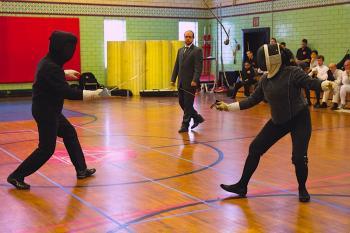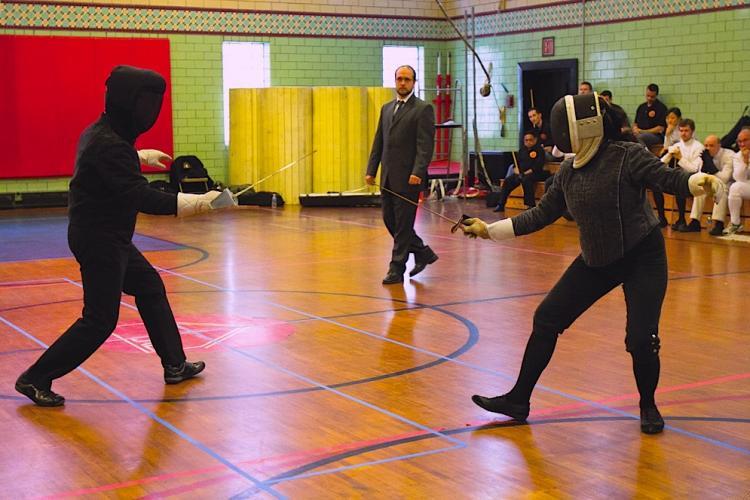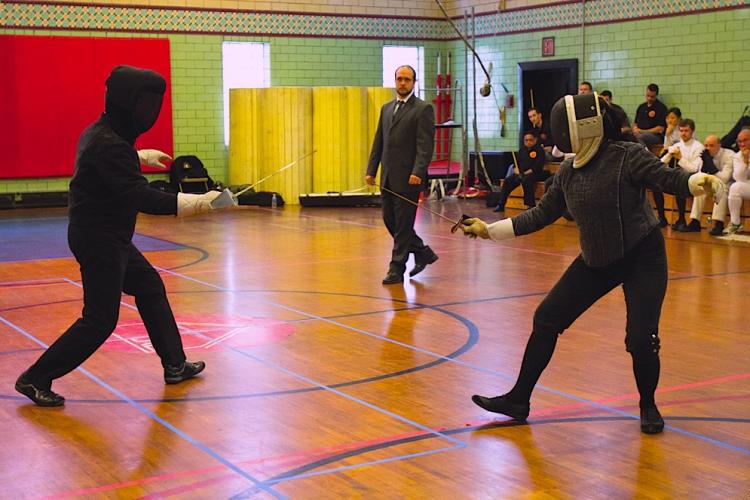NEW YORK—The ancient art of fencing gathered a crowd of about 75 people on Sunday afternoon at the Thompson Athletic Center in Soho, as the Association for Historical Fencing demonstrated a wide range of classical fencing techniques in their Traditional European Weapons Tournament.
In its eighth year, the association presented its Grand Assault of Arms, with finalists competing in foil, dueling sabre, dueling sword (also known as an épée), as well as single-stick techniques.
The event opened with the grand salute of arms, followed by fencing demonstrations from various schools of the art.
“Back in the day there were five, ten thousand people watching,” said the master of ceremonies, while joking that the crowd in attendance was a start for now.
Maestro Ramon Martinez and Maestro Jeannette Acosta-Martinez from the Martinez Academy of Arms described common traditions of various schools that comprise classical fencing. For example, competitors always salute each other before they begin and upon the conclusion of the match.
Both maestros also took turns explaining the differences between the French and Italian fencing art forms, including the contrast of weapons used.
The French foil is typically shorter than the Italian one, said Acosta-Martinez, and there is a lot of manipulation of the weapon. She also explained the differences in posture and hand movements between the two methods, as well as the many intricacies of their fencing techniques.
The shape of the weapon in the Italian school is different from that of the French, noted Martinez, adding that it is fastened to the wrist with a strap. He described the involved footwork with a musical term of “staccato” and demonstrated quick, vigorous steps.
“Classical fencing is a martial art, as it was for thousands of years,” said the emcee.
Most people are familiar with sword fighting as a sport where the objective is to hit your opponent before he hits you, he noted—if both opponents get hit, whoever hits first wins. In classical fencing, on the other hand, while the objective to hit your adversary remains, you must also ensure that you don’t get hit yourself.
“If in these battles both fencers are hit, that’s very bad,” noted the emcee.
Association for Historical Fencing, which is a nonprofit organization, hopes to bring back and educate the public about historical classical fencing by organizing seminars, lectures, and workshops, and by providing opportunities for fencers to continue to grow in their skills.
In its eighth year, the association presented its Grand Assault of Arms, with finalists competing in foil, dueling sabre, dueling sword (also known as an épée), as well as single-stick techniques.
The event opened with the grand salute of arms, followed by fencing demonstrations from various schools of the art.
“Back in the day there were five, ten thousand people watching,” said the master of ceremonies, while joking that the crowd in attendance was a start for now.
Maestro Ramon Martinez and Maestro Jeannette Acosta-Martinez from the Martinez Academy of Arms described common traditions of various schools that comprise classical fencing. For example, competitors always salute each other before they begin and upon the conclusion of the match.
Both maestros also took turns explaining the differences between the French and Italian fencing art forms, including the contrast of weapons used.
The French foil is typically shorter than the Italian one, said Acosta-Martinez, and there is a lot of manipulation of the weapon. She also explained the differences in posture and hand movements between the two methods, as well as the many intricacies of their fencing techniques.
The shape of the weapon in the Italian school is different from that of the French, noted Martinez, adding that it is fastened to the wrist with a strap. He described the involved footwork with a musical term of “staccato” and demonstrated quick, vigorous steps.
“Classical fencing is a martial art, as it was for thousands of years,” said the emcee.
Most people are familiar with sword fighting as a sport where the objective is to hit your opponent before he hits you, he noted—if both opponents get hit, whoever hits first wins. In classical fencing, on the other hand, while the objective to hit your adversary remains, you must also ensure that you don’t get hit yourself.
“If in these battles both fencers are hit, that’s very bad,” noted the emcee.
Association for Historical Fencing, which is a nonprofit organization, hopes to bring back and educate the public about historical classical fencing by organizing seminars, lectures, and workshops, and by providing opportunities for fencers to continue to grow in their skills.






